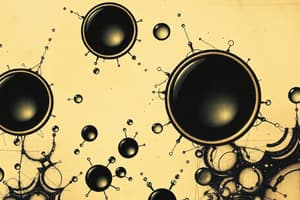Podcast
Questions and Answers
Emulsions consist of two miscible phases in a homogeneous system.
Emulsions consist of two miscible phases in a homogeneous system.
False (B)
The emulsifying agent is responsible for preventing the coalescence of particles in an emulsion.
The emulsifying agent is responsible for preventing the coalescence of particles in an emulsion.
True (A)
Oil in water (O/W) emulsions have the oil phase as the continuous phase.
Oil in water (O/W) emulsions have the oil phase as the continuous phase.
False (B)
Water in oil (W/O) emulsions consist of water droplets dispersed in an aqueous phase.
Water in oil (W/O) emulsions consist of water droplets dispersed in an aqueous phase.
Emulsions allow for faster absorption compared to solid dosage forms.
Emulsions allow for faster absorption compared to solid dosage forms.
Semisolid emulsions can be of the Oil/Water (O/W) type or Water/Oil (W/O) type.
Semisolid emulsions can be of the Oil/Water (O/W) type or Water/Oil (W/O) type.
The aqueous phase of O/W emulsions cannot be flavored.
The aqueous phase of O/W emulsions cannot be flavored.
W/O emulsions are generally preferred over O/W emulsions for topical applications.
W/O emulsions are generally preferred over O/W emulsions for topical applications.
Emulsions for internal use can be administered orally or by I.V. injection.
Emulsions for internal use can be administered orally or by I.V. injection.
The reduced particle size of oil globules does not affect its absorption and digestibility.
The reduced particle size of oil globules does not affect its absorption and digestibility.
All emulsifying agents must be toxic to ensure patient safety.
All emulsifying agents must be toxic to ensure patient safety.
Wetting agents can be categorized into anionic, cationic, and non-ionic types.
Wetting agents can be categorized into anionic, cationic, and non-ionic types.
Gelatin is a suitable emulsifier because it creates stable emulsions.
Gelatin is a suitable emulsifier because it creates stable emulsions.
Finely divided solids like bentonite can create either o/w or w/o emulsions depending on the mixing order.
Finely divided solids like bentonite can create either o/w or w/o emulsions depending on the mixing order.
High molecular weight alcohols are primarily used as emulsifying agents for internal applications.
High molecular weight alcohols are primarily used as emulsifying agents for internal applications.
Blending emulsifying agents often results in a less stable emulsion compared to using a single agent.
Blending emulsifying agents often results in a less stable emulsion compared to using a single agent.
The Continental or Dry Gum Method involves the emulsifying agent being mixed with water before the addition of oil.
The Continental or Dry Gum Method involves the emulsifying agent being mixed with water before the addition of oil.
Pectin and alginates are used to reduce the rate of separation in an o/w emulsion.
Pectin and alginates are used to reduce the rate of separation in an o/w emulsion.
There are four main methods of preparing emulsions, including the Wet Gum Method.
There are four main methods of preparing emulsions, including the Wet Gum Method.
In the dry and wet steps of emulsification, the first step is to add the desired consistency to the product.
In the dry and wet steps of emulsification, the first step is to add the desired consistency to the product.
The formula for the 4:2:1 method means that four parts of emulsifier are used for every two parts of oil.
The formula for the 4:2:1 method means that four parts of emulsifier are used for every two parts of oil.
Flashcards are hidden until you start studying
Study Notes
Emulsions
- An emulsion is a mixture of two liquids that are normally incompatible (cannot be mixed).
- One liquid is dispersed as tiny droplets throughout the other.
- The dispersed liquid is the internal phase, and the surrounding liquid is the external phase.
- An emulsifier is a substance that helps stabilize the emulsion, preventing the droplets from merging.
Types of Emulsions
- Oil-in-water (O/W): Oil droplets are dispersed in water.
- Water-in-oil (W/O): Water droplets are dispersed in oil.
Advantages of Emulsions
- Improve the administration of oils by masking their taste.
- Increase the absorption of oils.
- Allow for the convenient administration of liquid drugs.
Characteristics of Ideal Emulsifying Agents
- Compatible with other ingredients.
- Stable and do not deteriorate.
- Safe for consumption.
- Odorless, tasteless, and colorless.
- Facilitate emulsification and maintain stability.
Types of Emulsifying Agents
- Carbohydrates: Acacia, tragacanth, agar, and pectin. These typically form O/W emulsions.
- Proteins: Gelatin and egg yolk. These typically form O/W emulsions.
- High Molecular Weight Alcohols: Stearyl alcohol, cetyl alcohol, and glyceryl monostearate. Used as thickening agents for O/W emulsions.
- Wetting Agents: Anionic, cationic, and non-ionic surfactants. Non-ionic surfactants are effective over a wide pH range.
- Finely Divided Solids: Bentonite, magnesium hydroxide, and aluminum hydroxide. Can form O/W or W/O emulsions depending on the preparation method.
Methods of Emulsion Preparation
- Dry Gum Method: The emulsifying agent (often acacia) is mixed with the oil first, then water is added.
- Wet Gum Method: The emulsifying agent is mixed with the water first, then oil is added slowly.
- Bottle Method: Ingredients are shaken vigorously in a bottle to form an emulsion.
- In Situ (Nascent) Soap Method: Soap is formed in the emulsion by reacting an alkali and an oil during preparation.
Emulsion Preparation Steps
- Primary Emulsion: A thick, creamy, and stable emulsion is made initially.
- Dilution: Other substances are added gradually.
Continental or Dry Gum Method (4:2:1 Method)
- For every four parts of oil, two parts of water, and one part of gum are used to create an initial emulsion.
Studying That Suits You
Use AI to generate personalized quizzes and flashcards to suit your learning preferences.




